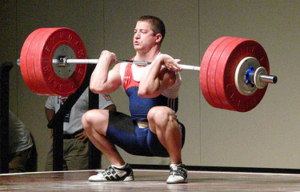 A recent study has proven that weight training can improve flexibility as well as - or perhaps better than - typical static stretching regimens. This study was released at the American College of Sports Medicine’s 57th Annual Meeting on June 4, 2010. The study was labeled: STRENGTH TRAINING IMPROVES FLEXIBILITY, TOO - Preliminary research shows no advantage for stretching. You can read the full report here and this is the description of the report along with the results below.
A recent study has proven that weight training can improve flexibility as well as - or perhaps better than - typical static stretching regimens. This study was released at the American College of Sports Medicine’s 57th Annual Meeting on June 4, 2010. The study was labeled: STRENGTH TRAINING IMPROVES FLEXIBILITY, TOO - Preliminary research shows no advantage for stretching. You can read the full report here and this is the description of the report along with the results below.
25 college age volunteers were randomly assigned to groups performing either resistance training or static stretching. A 12 person control group remained inactive. All were pre-tested on hamstring extension, hip flexion and extension, and shoulder extension flexibility, as well as peak torque of quadriceps and hamstring muscles. The resistance training and stretching programs focused on the same muscle-joint complexes over similar movements and ranges. Post-tests measured flexibility and strength.
The results - which may surprise advocates of stretching to improve flexibility- showed no statistically significant advantage of stretching over resistance training. Resistance training, in fact, produced greater improvements in flexibility in some cases, while also improving strength. Whitehead emphasized that this was a preliminary study involving a small sample size and called for carefully designed research with more participants to confirm or disprove the results.
It is hard to believe that this is the only study that I could find online that had anything to do with testing the conventional wisdom of weight training and flexibility. I first discovered that the belief of weight training limiting flexibility as being completely false when I first trained with the Olympic Lifters. I have posted a video of Coach Gayle Hatch who I have been mentored by and Matt Bruce who I have watched in "AWE" many times move weight like a beast when he looks like a little boy. Watch the USA Olympian Matt Bruce perform the back squat. He is moving around 250lbs in the video like it is nothing. His hip rotation and hip mobility is unbelievable. When I first witnessed this I said to myself, "How can someone like Matt, who looks like a boy, have this kind of joint flexibility and clean and jerk over his head, more 400lbs?" This blew my mind! I then ask myself why do pitchers not train like this?
This study above and the flexibility of these Olympic Lifters is proof that weight training does not reduce joint flexibility or mobility. This is because they train with weight moving through a full range of motion. Before I started lifting with the Olympic lifts in my pitching career, I was underdeveloped and my flexibility was horrible. I couldn't even touch my toes. After my first year of training my flexibility was unbelievable. I could not only touch my toes but I could kick my leg over my head. I believe this type of flexibility is far superior for the athlete than the type of flexibility developed through static stretching. Not only is this statement proven true in the above study but the science behind this theory makes perfect sense.
Functional Flexibility
Functional flexibility is a phrase that is used sometimes to define flexibility that is developed through dynamic or athletic movements. This means that the flexibility or mobility of the joint is built around the strength through a full range of motion. The opposite would be flexibility developed through static stretching which more than likely will develop flexibility in the joint without the strength. This may create a flexible athlete but it will not be functional because there is not enough strength through the entire range of motion. This type of mobility or flexibility is useless to the athlete. This is why a weight training program that trains the athlete through a full range of motion, with resistance, is building a stronger and more flexible athlete. This doesn't mean all you need to do is lift weights with a full range of motion because the range of motion must not push outside of the overall technique of the lifts. Sometimes training through a full range of motion can injure the athlete, so you must make sure that the technique of the lift is promoting a full range of motion and if it is not then you need to incorporate other exercises or lifts to cover the full range of motion for that specific joint, if necessary.
The purpose of this article was not to tell you that you need to use a full range of motion when lifting. It is to open a pitchers eyes to weight training as a means to not only developing strength but developing flexibility. You need to watch the instructional videos here to see how Olympic Lifting promotes joint mobility and you also need to get on an athlete/pitcher sport specific training program like the Fusion System in the 3X Pitching Velocity program to help you develop optimal strength and flexibility.



